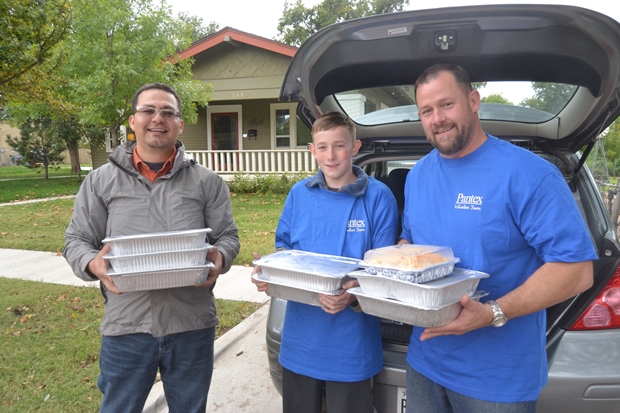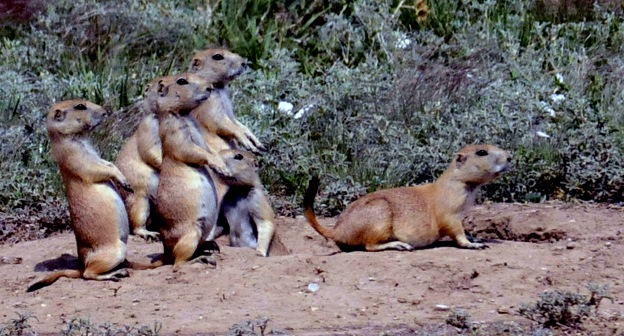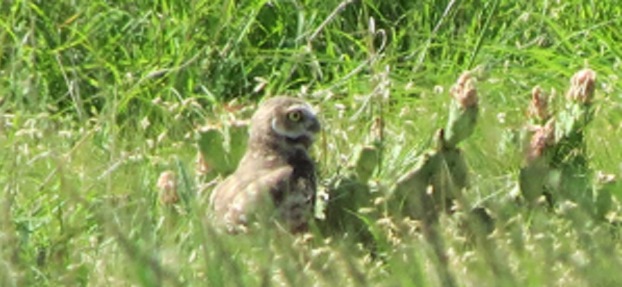Pantex Blog
Pantexans deliver ‘sunshine’ to single parents
A team of Pantex volunteers provided support to families in the Eveline Rivers’ Sunshine Cottages to put healthy meals on the table while the single parents prepared for finals. The cottages are housing for low‑income or homeless single parents who want to finish their education, work and raise their children in a safe environment.

Pantexans Caleb Rejino (left) and Danny Caverly, right, and Colin Caverly, Caverly’s son deliver meals to the Eveline Rivers Sunshine Cottages in Amarillo.
“Finals week can be a difficult time for anyone,” said Pantexan Caleb Rejino. “Eveline asked us to help the Sunshine Cottages by providing pre‑cooked or easy to prepare healthy meals. It is one less thing the parents have to worry about while studying for finals.”
Eveline Rivers, an Amarillo philanthropist, opened the Sunshine Cottages in 2001, with one home that was renovated into apartments. She now has six facilities with the goal to move “the whole family off the government system,” according to Eveline’s Sunshine Cottage website.
Residents of the Sunshine Cottages are required to take at least 12 hours of college classes each semester, work and ensure their children attend school. “These parents are working hard to finish their education and making sure their children learn by example,” Rejino said.
Rejino and members of his team delivered frozen casseroles and other items to the Sunshine Cottages Oct. 21. Rejino said nine members of the team cooked, and four anonymous Pantexans donated money to buy extra items.
The team was funded by Consolidated Nuclear Security. The Pantex Day of Volunteering was postponed so that both Y‑12 and Pantex can join forces next year. Some projects were approved for this year if the work couldn’t wait until 2016.
Pantexan Calvin Nelson secures recognition for expertise
Pantex’s own Calvin Nelson was recently awarded the 2015 Analyst of the Year for Transportation Security by the Department of Energy’s Nuclear Materials Information Program. The award, for which Nelson is the first‑ever Pantex recipient, recognizes outstanding analytic support to the NMIP.
 All transportation security analysts and criteria managers working in the program, including the national laboratories, submit nominations to the NMIP Program Management Office in Washington, D.C., where the finalists are selected. “Nominations are submitted based on an individual’s dedication, teamwork and diligence to the program,” said Tommy Butler, director of special programs. “For Calvin to be selected for this award is without a doubt noteworthy of his performance.”
All transportation security analysts and criteria managers working in the program, including the national laboratories, submit nominations to the NMIP Program Management Office in Washington, D.C., where the finalists are selected. “Nominations are submitted based on an individual’s dedication, teamwork and diligence to the program,” said Tommy Butler, director of special programs. “For Calvin to be selected for this award is without a doubt noteworthy of his performance.”
NMIP is a Presidential Directive program, meaning it was one of a few programs that have been briefed to President Obama. Besides covering transportation security, NMIP also covers site security as well as materials properties.
Even with his 30‑plus years of experience at Pantex, Nelson was not expecting to win the award. “I was really surprised when I got the notification that I had been selected,” Nelson said. “It is a great honor, and I’m so proud to have the opportunity to work with some great folks at the labs and at DOE Headquarters. Also, it’s been great to bring some of these folks that I work with to Pantex and show them our unique capabilities.”
Wild Pantex – Bird of the Day: The Dickcissel
Article by Jim Ray, Pantex Wildlife Biologist/Scientist
One of my favorite prairie birds is the Dickcissel. This native sparrow resembles a miniature meadowlark with its yellow breast and black bib. The Dickcissel’s name actually comes from the male's song –they spend a whole lot of time proclaiming their name and territory.
This summer, I had the pleasure of hearing a Dickcissel sing regularly as I walked from my car or work truck to the entryway to my office building. Several times while walking with someone I hollered out, "shhsh, hear that Dickcissel singing?" Of course, there was usually a wait period for the bird to sing again after the question rolled off my tongue. Normally, though, the Dickcissel didn't disappoint and soon announced his presence again.
The term Dickcissel usually puts a smile on the other person's face, maybe because with a name like that they think I must be pulling their leg. My next statement is invariably, "No, I am not kidding. These guys stay here to nest in these wetter years, and this was the second such notable year since I have worked out here.”
This native prairie sparrow likes the taller cover found here during our wetter years. Their nests are a bulky cup of weed and grass stems placed slightly above ground-level in dense grasses or in saplings. The nests are lined with finer grasses, rootlets and hair, upon which three to six unmarked, pale blue eggs are laid.
I first became familiar with the Dickcissel while attending graduate school in South Dakota. I lamented the fact (as a young wildlifer) that the state bird of South Dakota was an exotic bird – the Ring-necked Pheasant. Nevermind how much money the bird brings into the state's economy – state birds in this great nation should be native birds! In a prairie state it should be a good prairie bird!
"Which one," my summer technician once asked.
Since both of us thought that the Dickcissel was a great prairie bird, it was an easy choice! The Dickcissel is a great "bird of the day" designee. It is a welcomed visitor to our Wild Pantex, and the more years that we hear its voice, the better off we all are knowing that rainfall has been abundant here on the shortgrass prairie.

The shortgrass prairie is a productive ecosystem, including for ground-nesting songbirds. In some years, the Dickcissel makes irregular movements outside of its core breeding range to breed in surrounding areas of grassland.
Going pink from Texas to Tennessee
From Texas to Tennessee, Consolidated Nuclear Security employees were in the pink for October. More than 100 employees, friends and family members participated in the Susan G. Komen Race for the Cure in the two locations while other employees wore pink and even dyed their facial hair.

Pantex employees, friends and family members laced up their shoes for the Greater Amarillo Race for the Cure. CNS was a platinum sponsor of the event.
In Texas, about 75 Pantexans, friends and family members, including two breast cancer survivors, participated in the Greater Amarillo Race for the Cure. CNS contributed $2,500 to the Susan G. Komen Amarillo Affiliate as a platinum sponsor of the event and paid for employee registration. Curtis Chamberlain, a production manager, who ran in the event with his 11-year-old daughter, said it was a “good opportunity to spend quality time with her and support a worthy cause.”
In mid-October, Y-12 LiveWise hosted a women’s health fair and encouraged all employees to wear pink for breast cancer awareness. During the fair, employees could receive flu shots, participate in some health screenings and receive health information.

Employees, friends and family members from Y-12 prepared for the Knoxville Race for the Cure in the pre-dawn hours Oct. 24. (Photo by Big Orange Professional Photography)
A few weeks later in Tennessee, 33 Y-12ers joined the cause at the Knoxville Race for the Cure. CNS provided t-shirts for the runners in addition to covering employee registration fee. Shelia Scarfo of Y-12 participated with her two daughters. She said, “I walk with one of my daughters each year since my grandmother died from this disease, and my mother is a survivor.”
One Y-12 employee felt breast cancer awareness was worth significant attention and dyed his beard pink. Rodney Ryder, a lineman in Power Operations, dyed his beard pink noting “I have extended family members who are battling breast cancer.” When he went to a salon to inquire about dying it pink, the stylist agreed to do it (and provide any needed touch ups) for free, given the cause.
Ryder says all the teasing from co-workers is worth it. “When a woman tells me thank you or shares her story with me, I know my purpose of dying it was right. I’m thinking of doing it yearly,” he said.
Wild Pantex – Collaboration Produces Ninth Publication
Article by Jim Ray, Pantex Wildlife Biologist/Scientist
Yet another publication has come out of a research collaboration that studied black-tailed prairie dogs and western burrowing owls on and around the U.S. Department of Energy/National Nuclear Security Administration Pantex Plant from 2000–2005. Seven manuscripts have been published and two others have recently been accepted and are in publication.

Black-tailed prairie dogs at Pantex on alert.
Sixteen years ago, Pantex sought bids for a contractor to collaborate on research focusing on black-tailed prairie dogs and wildlife that are associated with habitat diversity promoted by the area consisting of burrows, short cover, bare-ground and a plant community that differs from the adjacent prairie. Pantex needed information for management decisions, and the black-tailed prairie dog was under review for federal listing as "threatened" following petitioning by one or more environmental groups. The western burrowing owl is dependent on prairie dogs for habitat (burrows and short cover) and is also attracted to the rich insect, amphibian, reptile, bird and small mammal communities that are known to inhabit prairie dog colonies.
The collaboration that ensued included Pantex, Texas Tech University and the U.S. Geological Survey's Texas Cooperative Fish and Wildlife Research Unit at Texas Tech. The Texas Parks and Wildlife Department also contributed, which allowed study sites located away from Pantex to be included, extending the study across the Southern High Plains. Several studies were initiated and conducted as multi-year, comprehensive research projects, and most have since been published in the peer-reviewed or refereed literature. There is also a popular article on burrowing owls that will appear in a magazine this winter.
So, what is the big deal? The work contributes to the information base on these two mentioned special status species and the habitat that prairie dog colonies provide to other species. Eight of the publications are peer-reviewed, which implies that the research was set up to yield scientific results, and scientists agree that interpretations will be valuable to conservation of the subject species and habitats. The popular article will share the work on the amazing little burrowing owl with birdwatchers and citizens — not at all unimportant to its conservation since prairie dog colonies constitute the owl's habitat, and prairie dogs, often considered a pest, are highly persecuted through control efforts. Most of all, the productivity of the collaboration that worked on the studies represents dedication to regional wildlife issues. Among the publications, there is a good mix of senior (first) authors being Pantex staff (three) and university staff (six).
Many thanks go out to the students, professors and cooperating landowners as well as the decision makers at Pantex. Altogether, these entities are great contributors to "Wild Pantex."
Titles of manuscripts, year and publication:
“Noteworthy distributional records of the prairie vole in the Texas and Oklahoma Panhandles,” 2003, Southwestern Naturalist
"Effects of radiotransmitter necklaces on behaviors of adult male western burrowing owls,” 2007, Journal of Wildlife Management
“Effects of human landuse on western burrowing owl foraging and activity budgets,” 2008, Journal of Raptor Research
“Association of black-tailed prairie dogs (Cynomys ludovicianus) with playa lakes and a new approach to estimating size of populations,” 2009, Southwestern Naturalist
“Small mammals and ground-dwelling invertebrates associated with active and controlled colonies of black-tailed prairie dogs,” 2009, Southwestern Naturalist
“Small mammals associated with colonies of black-tailed prairie dogs (Cynomys ludovicianus) in the Southern High Plains,” 2010, Southwestern Naturalist
“Avian use of black-tailed prairie dog colonies in shortgrass prairie,” 2015, Great Plains Research
“Factors influencing burrowing owl abundance in prairie dog colonies in the Southern High Plains of Texas,” in press, Journal of Raptor Research
“Tracking burrowing owls,” 2016, in press, Bird Watcher's Digest

Western burrowing owls are quite common in and near the prairie dog colonies on the Pantex facility.
